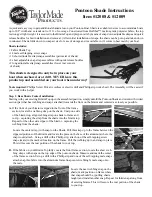
Trigger Mode/Coupling
11
Agilent InfiniiVision 2000 X-Series Oscilloscopes User's Guide
147
Trigger Indicator
The trigger indicator at the top right of the display shows whether triggers
are occurring.
In the
Auto
trigger mode, the trigger indicator can show:
•
Auto?
(flashing) — the trigger condition is not found (after the
pre- trigger buffer has filled), and forced triggers and acquisitions are
occurring.
•
Auto
(not flashing) — the trigger condition is found (or the pre- trigger
buffer is being filled).
In the
Normal
trigger mode, the trigger indicator can show:
•
Trig'd?
(flashing) — the trigger condition is not found (after the
pre- trigger buffer has filled), and no acquisitions are occurring.
•
Trig'd
(not flashing) — trigger condition is found (or pre- trigger buffer is
being filled).
When the oscilloscope is not running, the trigger indicator area shows
Stop
.
When to Use Auto
Trigger Mode
The
Auto
trigger mode is appropriate when:
•
Checking DC signals or signals with unknown levels or activity.
•
When trigger conditions occur often enough that forced triggers are
unnecessary.
When to Use
Normal Trigger
Mode
The
Normal
trigger mode is appropriate when:
•
You only want to acquire specific events specified by the trigger
settings.
•
Triggering on an infrequent signal from a serial bus (for example, I2C,
SPI, CAN, LIN, etc.) or another signal that arrives in bursts. The
Normal
trigger mode lets you stabilize the display by preventing the oscilloscope
from auto- triggering.
•
Making single- shot acquisitions with the
[Single]
key.
Often with single- shot acquisitions, you must initiate some action in the
device under test, and you don't want the oscilloscope to auto- trigger
before that happens. Before initiating the action in the circuit, wait for
the trigger condition indicator
Trig'd?
to flash (this tells you the
pre- trigger buffer is filled).
See Also
•
"Forcing a Trigger"
on page 125
•
"To set the trigger holdoff"
on page 150
Summary of Contents for 2000 X-Series
Page 1: ...s1 Agilent InfiniiVision 2000 X Series Oscilloscopes User s Guide ...
Page 20: ...20 Agilent InfiniiVision 2000 X Series Oscilloscopes User s Guide ...
Page 44: ...44 Agilent InfiniiVision 2000 X Series Oscilloscopes User s Guide 1 Getting Started ...
Page 58: ...58 Agilent InfiniiVision 2000 X Series Oscilloscopes User s Guide 2 Horizontal Controls ...
Page 66: ...66 Agilent InfiniiVision 2000 X Series Oscilloscopes User s Guide 3 Vertical Controls ...
Page 80: ...80 Agilent InfiniiVision 2000 X Series Oscilloscopes User s Guide 4 Math Waveforms ...
Page 104: ...104 Agilent InfiniiVision 2000 X Series Oscilloscopes User s Guide 6 Digital Channels ...
Page 110: ...110 Agilent InfiniiVision 2000 X Series Oscilloscopes User s Guide 7 Serial Decode ...
Page 116: ...116 Agilent InfiniiVision 2000 X Series Oscilloscopes User s Guide 8 Display Settings ...
Page 152: ...152 Agilent InfiniiVision 2000 X Series Oscilloscopes User s Guide 11 Trigger Mode Coupling ...
Page 178: ...178 Agilent InfiniiVision 2000 X Series Oscilloscopes User s Guide 13 Cursors ...
Page 214: ...214 Agilent InfiniiVision 2000 X Series Oscilloscopes User s Guide 16 Digital Voltmeter ...
Page 226: ...226 Agilent InfiniiVision 2000 X Series Oscilloscopes User s Guide 17 Waveform Generator ...
Page 244: ...244 Agilent InfiniiVision 2000 X Series Oscilloscopes User s Guide 19 Print Screens ...
Page 280: ...280 Agilent InfiniiVision 2000 X Series Oscilloscopes User s Guide 21 Web Interface ...
Page 352: ...352 Agilent InfiniiVision 2000 X Series Oscilloscopes User s Guide Index ...
















































